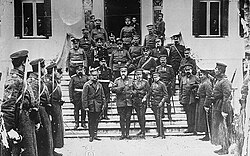
Back Guerra italo-turca AN الحرب العثمانية الإيطالية Arabic İtaliya–Osmanlı müharibəsi Azerbaijani ایتالیا-عوثمانلی ساواشی AZB Італа-турэцкая вайна Byelorussian Итало-турска война Bulgarian তুর্কি–ইতালীয় যুদ্ধ Bengali/Bangla Guerra italo-turca Catalan Италин-туркойн тӀом CE Italsko-turecká válka Czech
| Italo-Turkish War | |||||||||
|---|---|---|---|---|---|---|---|---|---|
| Part of the Scramble for Africa | |||||||||
 Clockwise from top left: Battery of Italian 149/23 cannons; Mustafa Kemal with an Ottoman officer and Libyan mujahideen; Italian troops landing in Tripoli; an Italian Blériot aircraft; Ottoman gunboat Bafra sinking at Al Qunfudhah; Ottoman prisoners in Rhodes. | |||||||||
| |||||||||
| Belligerents | |||||||||
|
|
| ||||||||
| Commanders and leaders | |||||||||
| Strength | |||||||||
|
Mobilisation 1911:[2] 4 battalions Alpini, 7 battalions Ascari and 1 squadron Meharisti |
Initial:[3] ~8,000 regular Turkish troops ~20,000 local irregular troops Final:[3] ~40,000 Turks and Libyans | ||||||||
| Casualties and losses | |||||||||
|
1,432 killed in action[4][5] 1,948 died of disease[4][6][5] 4,250 wounded[5] |
8,189 killed in action[7] ~10,000 killed in reprisals & executions[8] | ||||||||
| Events leading to World War I |
|---|
 |
|
The Italo-Turkish or Turco-Italian War (Turkish: Trablusgarp Savaşı, "Tripolitanian War", Italian: Guerra di Libia, "War of Libya") was fought between the Kingdom of Italy and the Ottoman Empire from 29 September 1911 to 18 October 1912. As a result of this conflict, Italy captured the Ottoman Tripolitania Vilayet, of which the main sub-provinces were Fezzan, Cyrenaica, and Tripoli itself. These territories became the colonies of Italian Tripolitania and Cyrenaica, which would later merge into Italian Libya.
During the conflict, Italian forces also occupied the Dodecanese islands in the Aegean Sea. Italy agreed to return the Dodecanese to the Ottoman Empire in the Treaty of Ouchy[9] in 1912. However, the vagueness of the text, combined with subsequent adverse events unfavourable to the Ottoman Empire (the outbreak of the Balkan Wars and World War I), allowed a provisional Italian administration of the islands, and Turkey eventually renounced all claims on these islands in Article 15 of the 1923 Treaty of Lausanne.[10]
The war is considered a precursor of the First World War. Members of the Balkan League, seeing how easily Italy defeated the Ottomans[11] and motivated by incipient Balkan nationalism, attacked the Ottoman Empire in October 1912, starting the First Balkan War a few days before the end of the Italo-Turkish War.[12]
The Italo-Turkish War saw some technological changes, most notably the use of airplanes in combat. On 23 October 1911, an Italian pilot, Capitano Carlo Piazza, flew over Turkish lines on the world's first aerial reconnaissance mission,[13] and on 1 November, the first aerial bomb was dropped by Sottotenente Giulio Gavotti, on Turkish troops in Libya, from an early model of Etrich Taube aircraft.[14] The Turks, using rifles, were the first to shoot down an airplane.[15] Another use of new technology was a network of wireless telegraphy stations established soon after the initial landings.[16] Guglielmo Marconi, the inventor of wireless telegraphy, came to Libya to conduct experiments with the Italian Corps of Engineers.
- ^ Erik Goldstein (2005). Wars and Peace Treaties: 1816 to 1991. Routledge. p. 37. ISBN 978-1134899128.
- ^ a b Translated and Compiled from the Reports of the Italian General Staff, "The Italo-Turkish War (1911–12)" (Franklin Hudson Publishing Company, 1914), p. 15
- ^ a b The History of the Italian-Turkish War, William Henry Beehler, pp. 13–36
- ^ a b Spencer C. Tucker; Priscilla Mary Roberts. World War I: A Student Encyclopedia. p. 946.
- ^ a b c Emigrant nation: the making of Italy abroad, Mark I. Choate, Harvard University Press, 2008, ISBN 0-674-02784-1, p. 176.
- ^ Translated and Compiled from the Reports of the Italian General Staff, "The Italo-Turkish War (1911–12)" (Franklin Hudson Publishing Company, 1914), p. 82
- ^ Lyall, Jason (2020). "Divided Armies": Inequality and Battlefield Performance in Modern War. Princeton University Press. p. 278.
{{cite book}}: CS1 maint: location missing publisher (link) - ^ Spencer Tucker, Priscilla Mary Roberts: World War I: A Student Encyclopedia, ABC-CLIO, 2005, ISBN 1-85109-879-8, p. 946.
- ^ "Treaty of Lausanne, October, 1912". www.mtholyoke.edu. Archived from the original on 25 October 2021. Retrieved 25 March 2018.
- ^ "Treaty of Lausanne - World War I Document Archive". wwi.lib.byu.edu. Retrieved 25 March 2018.
- ^ Jean-Michel Rabaté (2008). 1913: The Cradle of Modernism. Wiley-Blackwell. p. 7. ISBN 978-0-470-69147-2.
Realizing how easily the Italians had defeated the Ottomans, the members of the Balkan League attacked the empire before the war with Italy was over
- ^ Stanton, Andrea L. (2012). Cultural Sociology of the Middle East, Asia, and Africa: An Encyclopedia. Sage. p. 310. ISBN 978-1412981767.
- ^ Maksel, Rebecca. "The World's First Warplane". airspacemag.com. Retrieved 25 March 2018.
- ^ U.S. Centennial of Flight Commission: Aviation at the Start of the First World War Archived 2012-10-09 at the Wayback Machine
- ^ James D. Crabtree: On air defense, ISBN 0275947920, Greenwood Publishing Group, p. 9
- ^ Wireless telegraphy in the Italo-Turkish War